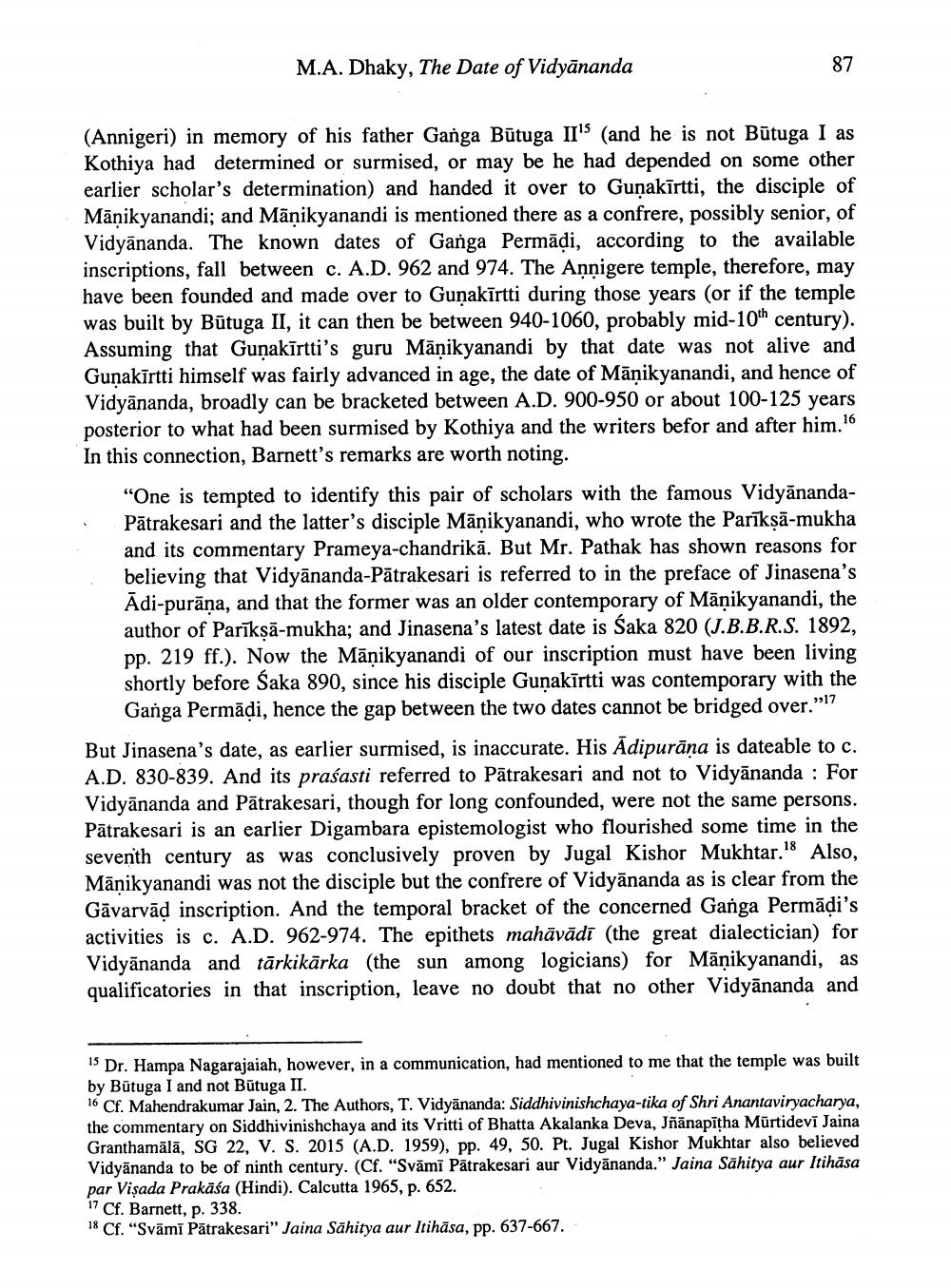________________
M.A. Dhaky, The Date of Vidyānanda
(Annigeri) in memory of his father Ganga Būtuga II" (and he is not Būtuga I as Kothiya had determined or surmised, or may be he had depended on some other earlier scholar's determination) and handed it over to Guņakīrtti, the disciple of Māņikyanandi; and Māņikyanandi is mentioned there as a confrere, possibly senior, of Vidyānanda. The known dates of Ganga Permādi, according to the available inscriptions, fall between c. A.D. 962 and 974. The Annigere temple, therefore, may have been founded and made over to Guņakīrtti during those years (or if the temple was built by Būtuga II, it can then be between 940-1060, probably mid-10th century). Assuming that Gunakīrtti's guru Māņikyanandi by that date was not alive and Gunakīrtti himself was fairly advanced in age, the date of Māņikyanandi, and hence of Vidyānanda, broadly can be bracketed between A.D. 900-950 or about 100-125 years posterior to what had been surmised by Kothiya and the writers befor and after him.16 In this connection, Barnett's remarks are worth noting.
"One is tempted to identify this pair of scholars with the famous VidyānandaPātrakesari and the latter's disciple Māņikyanandi, who wrote the Parīkņā-mukha and its commentary Prameya-chandrikā. But Mr. Pathak has shown reasons for believing that Vidyānanda-Pătrakesari is referred to in the preface of Jinasena's Adi-purāna, and that the former was an older contemporary of Mānikyanandi, the author of Parīksā-mukha; and Jinasena's latest date is Saka 820 (J.B.B.R.S. 1892, pp. 219 ff.). Now the Mānikyanandi of our inscription must have been living shortly before Saka 890, since his disciple Gunakīrtti was contemporary with the Ganga Permādi, hence the gap between the two dates cannot be bridged over.”!?
But Jinasena's date, as earlier surmised, is inaccurate. His Adipurāna is dateable to c. A.D. 830-839. And its prasasti referred to Pātrakesari and not to Vidyānanda : For Vidyānanda and Pātrakesari, though for long confounded, were not the same persons. Pātrakesari is an earlier Digambara epistemologist who flourished some time in the seventh century as was conclusively proven by Jugal Kishor Mukhtar.18 Also, Māņikyanandi was not the disciple but the confrere of Vidyānanda as is clear from the Gāvarvād inscription. And the temporal bracket of the concerned Ganga Permādi's activities is c. A.D. 962-974. The epithets mahāvādi (the great dialectician) for Vidyānanda and tārkikārka (the sun among logicians) for Mānikyanandi, as qualificatories in that inscription, leave no doubt that no other Vidyānanda and
15 Dr. Hampa Nagarajaiah, however, in a communication, had mentioned to me that the temple was built by Būtuga I and not Būtuga II. 16 Cf. Mahendrakumar Jain, 2. The Authors, T. Vidyānanda: Siddhivinishchaya-tika of Shri Anantaviryacharya, the commentary on Siddhivinishchaya and its Vritti of Bhatta Akalanka Deva, Jñānapītha Mūrtidevī Jaina Granthamālā, SG 22, V. S. 2015 (A.D. 1959), pp. 49, 50. Pt. Jugal Kishor Mukhtar also believed Vidyānanda to be of ninth century. (Cf. "Svāmī Pātrakesari aur Vidyānanda." Jaina Sahitya aur Itihasa par Vişada Prakāśa (Hindi). Calcutta 1965, p. 652. 17 Cf. Barnett, p. 338. 18 Cf. "Svāmī Pātrakesari" Jaina Sāhitya aur Itihāsa, pp. 637-667.




